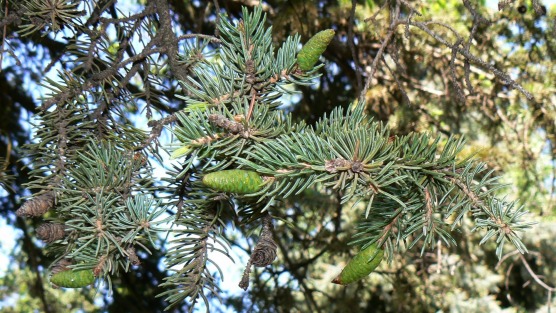The white spruce is one of four native trees in Calgary, the others being the Rocky Mountain Douglas fir, the balsam poplar, and the trembling aspen.
The white spruce’s Latin binomial, Picea glauca, is the scientific name used around the world for accuracy. The first word, Picea is its genus. All spruce trees’ names start with Picea. The second word is the species name; glauca means bluish green or greenish grey.
The white spruce is one of four native trees in Calgary, the others being the Rocky Mountain Douglas fir, the balsam poplar, and the trembling aspen. All other trees in Calgary are introduced. Some of the introduced trees are naturalized, meaning that they reproduce on their own and thrive here. You will know this for sure if your garden is near a female green ash, a female Manitoba maple, an elm, or several others.
The white spruce is one of the most common trees in the world. It is a major component of the northern boreal forest, or Taiga, which is a vast forest region encircling the north polar regions. An image may help: if the world were an eye and the pupil was the treeless arctic, then the boreal forest is the iris. This immense forest is the worlds largest terrestrial biome.
None of this takes away from the wonder of having a white spruce in your garden. Relatively trouble free, they survive with a minimum of care. The oldest and largest trees are in our oldest intercity communities. In Mount Royal and other areas, hundred-foot trees are not uncommon.
There are a number of disease and insect problems affecting the white spruce. Most important is the yellow-headed saw fly, Pikonema alaskensis, which in its larva stage can be a serious defoliator. A high population can eat enough needles to leave the tree with bare branches and not enough photosynthetic mass to feed itself. This is a rare case when spraying is probably the best answer to save your tree. Most spruce have a few larvae in June, but if your tree is infested, you should spray.
Other common insects affecting the white spruce are:
One disease needs mention, and that is Leucostoma canker or Cytospora canker of spruce. This fungal canker invades lower branches of spruce trees. The tree tries to flush out the pathogen; dead branches and telltale staining of silvery-blue sap on branches and the trunk are positive identifiers. Remove affected branches and water the tree heavily. Chances are the tree was infected because its defenses were weak due to water stress.
Any tree in Calgary that gets the water that it wants will be disease and pest free.
The white spruce can be very long-lived. Trees over 500 years old were logged from Hidden Creek in southern Alberta. Perhaps there is an oldie like that hidden along the Douglas Fir Trail?
An ancient tree has a real presence; you may find that tree by feeling it.
Good luck!









